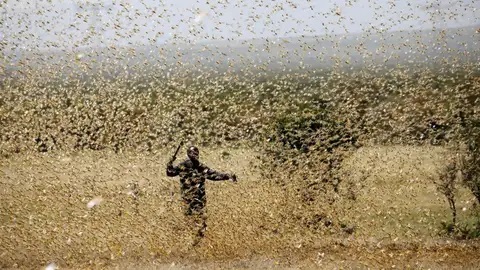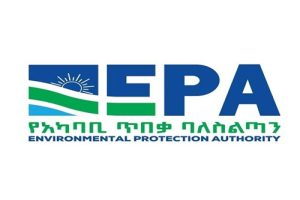
BY STAFF REPORTER
The Horn of Africa region is recurrently vulnerable to desert locust outbreak. In recent years it has caused damages in Ethiopia and neighboring countries. The forecast and early warning system of institutions like the regional block, IGAD, is an important way to prevent the possible holocaust that recurrently happen in the region.
Recently IGAD has projected that the period spanning July to mid-August could witness movement of mature swarms across the region due to favorable weather. “The risk of significant impact to both crops and rangelands is high in Ethiopia, Sudan and Somalia due to swarms recorded at the critical time of planting of main season cereal crops”
The IGAD-affiliated Climate Prediction and Applications Center (ICPAC) in its June-July desert locust situation update for the Horn of Africa region said that maturing hoppers have been spotted in different parts of Ethiopia, Djibouti and Somalia, Xinhua reported quoting the regional bloc. As breeding and reproduction of the voracious pest has intensified amid above-average rainfall, lush vegetation, the strong winds could enhance their mobility in the region.
According to the updated report, the hoppers have been reported in north-western regions of Somalia, where their numbers are increasing, while in Sudan, adult locusts have been spotted in six states.
According to IGAD, the planting season in Ethiopia could be in jeopardy due to the looming desert locust invasion fueled by heavy rainfall predicted in the months of July and August. And the desert locust control operations have been affected by skirmishes in Tigray and Afar, which could increase the numbers of locusts and cause great damage to crops and pasture.
Ecological conditions expected to fuel the spread of desert locusts in the region include abundant rains, green pasture, wind direction and intensity. “Conditions that favor swarms migration in search of areas to lay eggs and moist sandy soils are suitable in the north of the region,” said IGAD.
Eastern Africa has been battling the worst Desert Locust invasion in the last 70 years [1], as a result of the Indian Ocean’s warming and the increasing number of cyclones affecting the region. Outbreaks, like the current desert locust invasion, are expected to increase in the future, pointing to the need for increased investment in monitoring, control and early action. These require strong transnational early warning systems and control measures.
Countries in the region are still working to contain the desert locust outbreak, especially Ethiopia and Somalia. Pest outbreaks are one of the compounding shocks currently exacerbating food insecurity in the region, in addition to conflict, macro-economic challenges, the socio-economic impacts of COVID-19, and the increasing frequency and intensity of climate extremes. H.E. Dr Workneh Gebeyehu, the IGAD Executive Secretary highlighted that “Our region remains one of the most vulnerable to food insecurity in the world.
According to the Food Security and Nutrition Working Group statement for April 2021, there are over 32 million people faced by Crisis or worse food insecurity status (IPC/CH Phase 3 or higher) in the IGAD region.” In support of the inter-regional platform Dr. Shobha Shetty, Manager in Agriculture and Food, Africa East/South of the World Bank stated “I am happy to announce that the World Bank has also just approved a 3 million Dollar grant to IGAD to start the inter-regional platform to facilitate exchanges among countries, regional organizations, and international organizations in the Horn of Africa.”
According to relief web, in a recent IGAD Ministerial Conference on the Sustainable Management of Desert Locust and other Transboundary Pests the countries have agreed to establish an inter-regional platform to facilitate exchanges between frontline countries in the Horn of Africa and the Arabian Peninsula, and invasion countries. The platform will aim to enhance institutional arrangements and create a joint/coordinated strategy for frontline and invasion countries, coordinate response, training plans, sharing of information, and conducting south-south exchange programs to promote experience sharing and learning.
The decision also stipulates the need to enhance the provision of timely and actionable Early Warning information to all actors by strengthening the IGAD Climate Prediction and Applications Centre (ICPAC).
The ministers also decided to develop Inter-regional Pests Early Warning System, national and regional risk assessment and crisis management plans, as well as, national and regional preparedness plans encompassing the required institutional and human capacity, infrastructure/technology, training programs, research, and information required for a sustainable national system.
Furthermore, they stressed the need to develop research agenda on the use of bio-pesticides, utilization of desert locusts for food/feed, the gene isolation for the identification of pheromone producing chemicals.
Establish public-private partnership (PPP) agreements at the national and regional level to maintain and strengthen the availability of supplies and services needed to respond to desert locusts and other pest outbreaks, while learning from the current upsurge about the role of the private sector as a key partner in the fight against pests.
THE ETHIOPIAN HERALD AUGUST 3/2021




